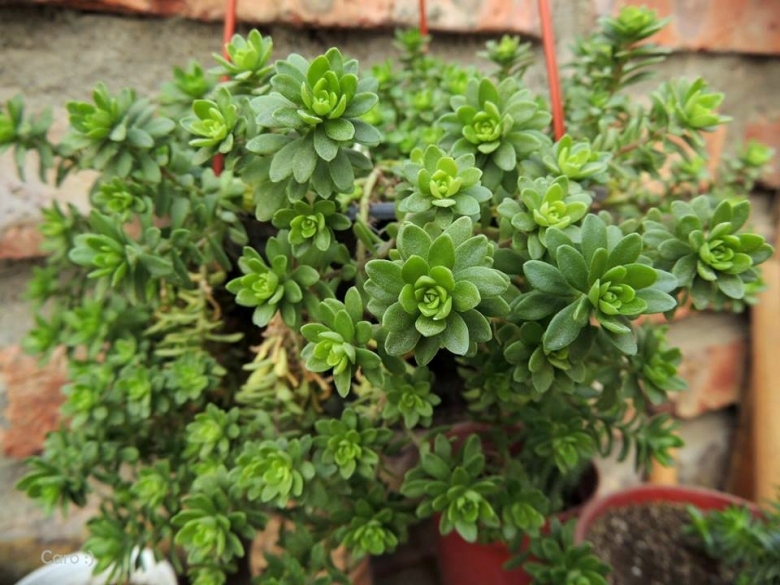




Your support is critical to our success.

Origin and Habitat: Sedum x luteoviride is a natural hybrid between Sedum praealtum subsp. parvifolium and Sedum greggii, from Mexico (Hidalgo). The species was described from a cultivated plant, but the nativity was wrongly indicated in Index Kewensis as California.
Synonyms:
- Sedum х luteoviride R.T.Clausen
Description: The yellow-flowered Sedum x luteoviride appears to be a natural hybrid, (Sedum praealtum X Sedum greggii). The most notable feature of this evergreen succulent subshrub is its thick short leaves at right angles to the stem. The leaves typically are glossy yellow-green when grown in shade, but in strong light the tips turn a fleshy red colouration, which can deepen to orange-red in full sun. Winter colour tends to cinnamon with green. Yellow flowers appear in profusion early in the year, in both terminal and lateral clusters, with smaller, bractlike leaves tucked in close to them. Over time, the plant becomes more or less tufted, dense, erect, to 15 cm tall, 3-15 or more cm across, and the lower two thirds of the stems become bare. Both parents are very different from this hybrid: Sedum praealtum has long, entire, flat leaves, while Sedum greggii has small, cone-shaped rosettes of foliage. Large plants may become quite robust and appear like diminutive Sedum dendroideum DC. Small plants, particularly those which are well-watered, may be more lax and sprawling.
Stems: Glabrous, robust, branched and procumbent at base, rigid and erect at tips, green to flesh-red coloured 2-6 mm in diameter, up to 32 cm long.
Leaves: Alternate, in spiral, condensed in zones on the stems, 5-16 mm long, 3-6 mm wide, 1-2 mm thick, almost round, then elongating or subspatulate, glossy, bright yellowish-green, becoming an orangy-green if grown outdoors in summer. A peculiarity of the foliage is the occurrence on the stems of alternating zones of long and short leaves.
Flowers: in both terminal and lateral 7-30-flowered cymes. Flowers are sessile or born on short peduncles up to 2 mm long. Flowers are bright yellow 10-12 mm in diameter. Sepals 5, almost equal yellowish-green, oblong, obtuse, 2 mm long; petals 5, yellow, oblong-lanceolate, pointed, 4-6 mm long; stamens yellow, 2-4 mm long; anthers oblong, 0.5-0.6 mm long; pistils green-yellow, spreading, 3-4 mm long.
Seed: Sub-ovate, smooth, 0.8 mm long.
Bibliography: Major references and further lectures
1) Brent Horvath “The Plant Lover's Guide to Sedums” Timber Press, 22 April 2014
2) Sedumphotos,net “Sedum luteoviride” <http://www.sedumphotos.net> Web. 22 May 2015.
3) The Alpine Garden Society “Sedum luteoviride” <http://encyclopaedia.alpinegardensociety.net> Web. 22 May 2015.
4) R. T. Clausen “Sedum luteoviride R. T. Clausen. sp. nov.” Cact. Succ. J. (Los Angeles) 18: 74 1946.
Cultivation and Propagation: Sedum x luteoviride is always an interesting plant and easy to grow in container or in the rock garden in frost free areas. It is tough, sun and drought tolerant, but also will do well in partial-shade. This is a terrific plant for a small container. The plants make active growth in fall/winter, unlike most other stonecrop and propagate easily. Few plants need less attention than sedums.
Soil: Porous soil with adequate drainage. Outdoors it does not prefer rich loamy soil; gritty dirt with pea gravel suits it.
Repotting: Repot only if you see roots coming out of the pot's drainage holes.
Fertilization: Feed them once a season with a water-soluble foliage houseplant fertilizer diluted to half strength. For outdoor plants, cut old stems back to ground level in the spring, and apply a small amount of general-purpose fertilizer. Water well to move the fertilizer down to the roots.
Wateing: It takes little water & could rot if watered too often. During water thoroughly when soil is dry to the touch. It is not quite as succulent as the majority of the species and wilts although it can take a great deal of drought, it seem to do better with regular (but moderated) watering and it is best to refrain from watering it until the rootball has dried out completely. During the winter months, plants are watered very little. Its succulent leaves will store enough water to survive for long time. For outdoor plants, additional watering is rarely needed, except during extended droughts.
Exposition: It need full sun to light shade with ample airflow, but a sunny spot is nicest, though in warmer climates it needs protection from too much sun because it is not very heat tolerant. It needs bright light over winter.
Frost Tolerance: Fairly hardy for a Mexican Sedum. Hardy in south-western Britain. ZONES (8)9-11. In a warmer climate, it could be tried outside, but keep an extra plant inside for winter, just in case.
Uses: Use them in rock gardens, dish gardens or as a fast-spreading ground cover for dry areas, especially on slopes.
Propagation: This is a tough plant which spreads easily by cuttings in summer. Remove a small piece of stem and left for a period of 2-3 days to callous. Then insert the end of the stem into a container filled with fast-draining potting soil. Water it well, then put the pot in a bright spot out of direct sunshine. Water it whenever the top inch of soil feels dry. In a few weeks it will develop healthy roots. It can also be propagated by seeds; sprinkle the seeds over the surface of damp seed-starting medium; the seeds need light to germinate so don't cover with more medium. Cover the container with plastic wrap and place it in a brightly-lit spot where the temperature stays 10-15° C. Germination should take 15 to 30 days, but it can be erratic. Some seeds may germinate months later, especially if they are sown outdoors.
| Your Actions | |
|---|---|
| Back to Sedum index | |
| Back to Crassulaceae index | |
 |
Back to Succulents Encyclopedia index |
Privacy stantement - Terms and conditions - How to cite - About us - Feedback - Donate



